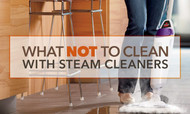What NOT to Clean with Steam Cleaners
Aug 03, 2020
Steam cleaners are wonderful since they can clean just about anything without the use of harsh chemicals—car exteriors, sealed hardwood floors, leather upholstery, most kitchen appliances, windows, mirrors, and showers.
There are some surfaces, however, that aren’t ideal for steam cleaners.
How Do Steam Cleaners Work?
Let’s look at how steam cleaners work. Essentially, they turn ordinary tap water into deep-cleaning steam vapor. They do this with heat – lots of it. In order to kill germs, they need to heat water to at least 225 degrees F. In fact, the most powerful steam cleaners, like Ladybug Steam Cleaners, heat the water as high as 325 degrees F.
What You Shouldn’t Steam Clean
That chemical-free cleaning is great for your indoor air quality, but some surfaces just can’t take all that heat. Here are a few things you shouldn’t clean with steam vapor:
- Anything that can be damaged due to heat exposure, such as water-based paint and cardboard
- Porous surfaces, such as stucco, brick, and marble
- Large industrial spaces and food plants
- Large areas of carpet
- Delicate items, such as silks, thin plastics, and velour upholstery
You may have tried steam cleaning these surfaces, and you may have been somewhat successful. But here is why it isn’t recommended:
Technically, a steam cleaner can clean large spaces, but it isn’t the most effective way to do so. Some silk items can also be steam cleaned with caution, but it isn’t suggested because the heat could ruin them. In addition, steamers clean sidewalks and cracks, but they probably don’t have enough power to clean them as well as other products (like a pressure washer).
Check out our Steam Cleaner FAQs for a run down on some things you can clean with steam cleaners, how to eliminate allergies, and more!
Natural Cleaning Solutions
 Luckily, there are ways to clean such surfaces without resorting to nasty chemicals. Here are a few natural cleaning alternatives to try:
Luckily, there are ways to clean such surfaces without resorting to nasty chemicals. Here are a few natural cleaning alternatives to try:
- Damp cloth: Use a warm, damp cloth to wipe down latex-painted walls
and many other surfaces sensitive to the extreme heat of steam cleaners. - Baking soda (sodium bicarbonate): Sprinkle baking soda on carpet or upholstery, let sit several minutes, and then vacuum up.
- Washing soda: A close cousin to baking soda, washing soda (sodium carbonate) can be used to clean oil spots from cement garage floors. Sprinkle on the spot along with some water to make a paste and let sit overnight. Then scrub with a brush, rinse off and wipe down.
- Vinegar: Vinegar is a wonderful natural cleaner. Mix 1/4 cup with 2 cups water, spray on windows and wipe clean. You can also add a splash of vinegar to a bucket of warm water and use for mopping most floors. For moldy walls, spray vinegar on and let sit several minutes before wiping off.
- Castile soap: This natural olive oil-based soap can be used for a variety of cleaning projects. Mix 1/4 cup with 2 gallons of warm water for a floor-cleaning solution, and combine 1 tablespoon of the soap with 1/3 cup baking soda for a natural cleaning scrub for showers, tubs, tile, and sinks.
- Olive oil: For a natural furniture polish, mix 2 cups of olive oil with 2 tablespoons of lemon juice and rub on with a soft cloth.
What You CAN Clean with Steam Cleaners
Remember: While you should treat these delicate surfaces with care, for the most part, steam cleaners can safely clean just about any surface in your home or office. Check our Steam Cleaner Buying Guide for a full list of items you can clean with steam vapor.
Source - https://www.sylvane.com/blog/what-not-to-clean-with-steam-cleaners/



